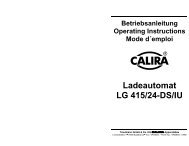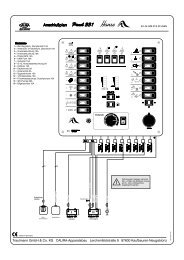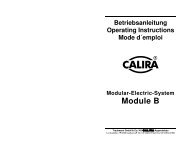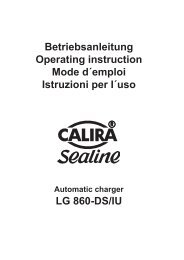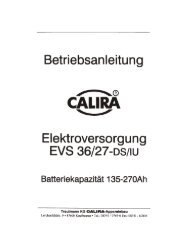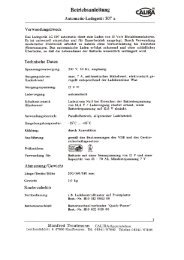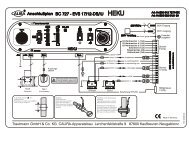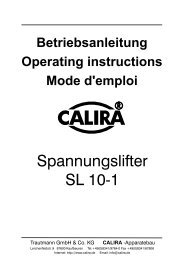Electric-System EVS 38/20-DS/IU - Calira
Electric-System EVS 38/20-DS/IU - Calira
Electric-System EVS 38/20-DS/IU - Calira
Create successful ePaper yourself
Turn your PDF publications into a flip-book with our unique Google optimized e-Paper software.
Fig. 21: Mains<br />
connection<br />
Commissioning<br />
' & "<br />
Check that all the connections are firm and secure.<br />
Finally implement the mains connection via the female<br />
connector of the mains cable. The socket on the device is<br />
provided with a locking. When connecting the plug, make<br />
sure that the locking engages. In order to remove the<br />
plug, the locking must be released by lightly raising its<br />
wing.<br />
The power supply is operational as soon as it is connected to the mains.<br />
Before breaking or making direct-current connections, e.g. the charging cable<br />
at the battery, the device be switched off at the mains. Pull out the mains plug.<br />
Never charge batteries with short-circuited cells!<br />
Charging a battery<br />
Explosive gases (oxyhydrogen) are produced if charging is carried out with a<br />
short-circuited battery, or when the automatic charging controller is nonoperational.<br />
Therefore it is necessary to ensure sufficient external ventilation in<br />
the battery space. Avoid sparks and open flames!<br />
Prerequisites<br />
The battery must have a rated voltage of 12 volt and a minimum capacity of 70<br />
Ah. Insufficient charging takes place if the battery is below this value. Batteries<br />
with a capacity that is too high are charged too slowly.<br />
Attention<br />
Batteries with short-circuited cells must not be charged. Explosion hazard due<br />
to the generation of oxyhydrogen gas!<br />
Charging process<br />
Battery charging proceeds automatically. After a mains failure, the main<br />
charging process is automatically started again. The main charging process<br />
ends when a battery voltage of 14.4 volt is reached. After the post charging<br />
phase, the device switches to holding charge of constant 13.8 volt.<br />
Parallel operation<br />
In parallel operation, the current drawn up by electrical equipment should be<br />
less than the maximum charging current of <strong>20</strong> A. This is the only way to ensure<br />
that the battery is being charged even though consumers are being supplied.<br />
42<br />
! "#$ %&&<br />
Lerchenfeldstr. 9 87600 Kaufbeuren Tel.: +49(0)8341 / 9764-0 Fax: +49(0)8341 / 67806



